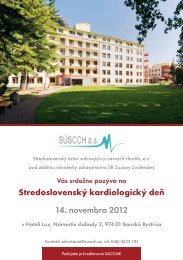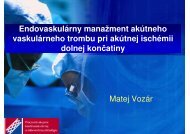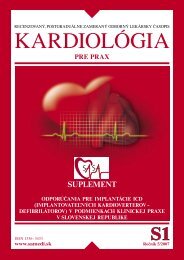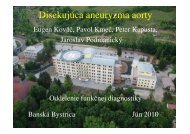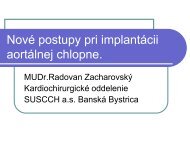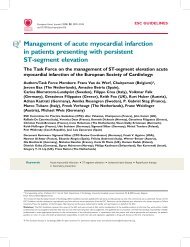Endovaskulárne techniky rekanalizácie femoropliteálnych okluzií
Endovaskulárne techniky rekanalizácie femoropliteálnych okluzií
Endovaskulárne techniky rekanalizácie femoropliteálnych okluzií
You also want an ePaper? Increase the reach of your titles
YUMPU automatically turns print PDFs into web optimized ePapers that Google loves.
Subintimal angioplasty for advanced lower extremity ischemia due to<br />
TASC II C and D lesions of the superficial femoral artery. Sidhu R et al.<br />
Vasc Endovascular Surg. 2010 Nov;44(8):633-7. Epub 2010 Jul 30<br />
OBJECTIVE:<br />
Subintimal angioplasty (SA) has evolved into a viable<br />
revascularization procedure for complex lower extremity lesions. Although<br />
patency rates are lower than those for autogenous bypass, limb salvage rates<br />
are comparable. This study reviewed the 8-year experience of SA in a single<br />
center.<br />
METHODS:<br />
Records of patients undergoing SA were reviewed. Clinical presentation and<br />
noninvasive exams were used to classify patients. Lesions were categorized by<br />
TransAtlantic InterSociety Consensus (TASC) II guidelines. Outcomes included<br />
technical success, patency, amputation-free survival, and limb salvage.<br />
RESULTS:<br />
120 patients with TASC II C/D lesions underwent SA. Technical success was<br />
91%. Primary patency at 6 and 12 months was 90% and 73%. Secondary<br />
patency at 6 and 12 months was 94% and 85%. One-year amputation-free<br />
survival was 90%. One-year limb salvage was 98%.<br />
CONCLUSIONS:<br />
SA for TASC C/D lesions is a safe procedure and may be considered an<br />
alternative to bypass, especially in high-risk patients.



